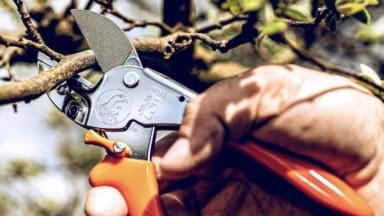
Anvil secateurs were invented in Germany in 1923 by Walter Schröeder, roughly a century after the first secateurs were invented in France. In Europe, Schröeder’s secateurs were sold under the brand ‘Original LÖWE’ from 1925. Colonel B. J. Walker brought them to England in 1928, creating the Rolcut brand – still recognised by many gardeners today. From 1945, they were also manufactured in England and exhibited at the Chelsea Flower Show.
Rolcut was bought by another tool company in the 1990s, and the much-loved anvil secateurs disappeared. Former John Lewis buyer, Dan Cooper of Dan Cooper Garden, a specialist garden ware company in Kent is reintroducing Original LÖWE secateurs to the UK – one year after the Original LÖWE Model 1 celebrated its centenary. Influenced by his grandfather who was a head gardener at a country estate, Cooper’s first pair of pruners were this very design.
Cooper explains: “They are durable, versatile, inexpensive, and were made in England for a long time. Anvil secateurs are arguably the only major innovation in pruning tools since the invention of secateurs two hundred years ago. If you look hard enough, you will find vintage Rolcut secateurs in online marketplaces, but otherwise they haven’t been available for 30 years.”
According to Cooper, gardeners simply use bypass secateurs for everything, often for jobs they’re not best suited for. By reintroducing gardeners to anvil secateurs, the “misuse of bypass secateurs” may be prevented. “Once you’ve seen how effectively anvil secateurs handle tough pruning work, you’ll be a convert”, said Cooper.
With an exclusive licence from LÖWE, Cooper is set to re-launch this garden classic, which he has chosen to do at this coming weekend’s at the Autumn Plant Fair at Borde Hill Garden in West Sussex. “I’m so excited to be unpacking and showcasing these fantastic secateurs in the UK for the first time in over thirty years. And Borde Hill’s Autumn Plant Fair feels like the most appropriate place to relaunch these anvil secateurs. They have a single blade, sharpened on both sides and work much like a knife on a chopping board, slicing through autumnal stems and branches brilliantly.”

